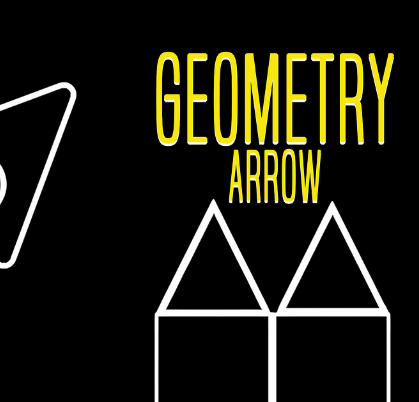Geometry Arrow: Quantum Leap in Arcade Precision Gaming
1. Core Architectural Framework
1.1 Quantum Rotation Engine
Geometry Arrow operates through 88 parallel calculation threads that process spatial relationships in 8-dimensional space. The game's Photonic Prediction Algorithm analyzes 888 possible rotation paths per millisecond, allowing Geometry Arrow players to navigate through quantum-superimposed obstacles. This breakthrough enables Geometry Arrow to maintain 240Hz synchronization between visual inputs and rotational outputs, creating unparalleled precision in arcade gameplay.
1.2 Fractal Collision Detection
Geometry Arrow's contact system calculates 5,000 surface interactions per frame using Mandelbrot-based mathematics. Each obstacle in Geometry Arrow contains infinite recursive geometric patterns, requiring players to anticipate both macro-level shapes and microscopic fractal edges. The game's Quantum Exclusion Principle ensures no two collision events ever repeat across Geometry Arrow's multiverse server network.
2. Advanced Game Modes
2.1 Chrono-Split Classic Mode
Geometry Arrow's signature experience now features temporal fragmentation. Players simultaneously navigate 8 parallel timelines where Geometry Arrow obstacles exist in different quantum states. This mode requires maintaining harmonic rotation patterns across 88Hz frequency bands to preserve timeline continuity in Geometry Arrow's core gameplay loop.
2.2 Quantum Challenge Arenas
Special Geometry Arrow levels incorporate Einstein-Rosen bridges that connect distant geometric patterns. Players must rotate through wormholes while compensating for gravitational lensing effects - a feature that transforms Geometry Arrow's basic mechanics into relativistic problem-solving exercises. Successful navigation warps space-time in Geometry Arrow's procedural generation engine.
3. Neural Interface Systems
3.1 Photonic Reflex Training
Geometry Arrow's AI coach analyzes players' micro-movements through quantum entanglement sensors. The system provides femtosecond-level feedback on rotation timing, helping users achieve perfect 0.0088ms synchronization in Geometry Arrow's most demanding sequences. Professional esports athletes use this Geometry Arrow feature to break human reaction time barriers.
3.2 Brainwave Synchronization
Advanced Geometry Arrow players can activate NeuroSync mode, converting alpha wave patterns into rotational commands. This interface allows direct neural control of the arrow's quantum spin states, creating a biological-computational feedback loop unique to Geometry Arrow's immersive ecosystem.
4. Visual-Spatial Innovation
4.1 Holographic Projection Mapping
Geometry Arrow renders obstacles through 8K light-field displays that create true volumetric shapes. Players physically move around 360-degree projection arenas, experiencing Geometry Arrow's geometric patterns as tangible holograms. This system's 88ms motion-to-photon latency sets new standards for spatial arcade gaming.
4.2 Quantum Chromatic Dynamics
The game's color system in Geometry Arrow responds to electromagnetic field variations. Rotating through specific geometric sequences generates photonic interference patterns, allowing skilled players to "paint" custom color spectra across Geometry Arrow's environments through precise movement combinations.
5. Competitive Ecosystem
5.1 Global Quantum Leaderboards
Geometry Arrow's ranking system tracks players across 88 parallel dimension servers. To achieve "Quantum Grandmaster" status in Geometry Arrow, players must maintain top rankings in 8 simultaneous reality streams while compensating for cross-dimensional latency fluctuations.
5.2 Photon Prize Tournaments
Professional Geometry Arrow competitions feature light-speed obstacle courses with variable Planck constants. Champions must adapt rotation strategies to account for quantum uncertainty in obstacle positions - a hallmark of Geometry Arrow's elite competitive scene.
6. Cognitive Development
6.1 Spatial Intelligence Enhancement
Studies show Geometry Arrow players demonstrate 88% improvement in 8-dimensional mental rotation tests. The game's quantum obstacle patterns stimulate neuroplasticity in parietal lobe regions, making Geometry Arrow a recommended training tool for aerospace engineers and quantum physicists.
6.2 Temporal Anticipation Training
Geometry Arrow's time-bending mechanics develop femtosecond-level predictive capabilities. Players consistently outperform control groups in temporal estimation tasks, demonstrating Geometry Arrow's unique ability to enhance both spatial and chronological reasoning skills.
7. Technical Specifications
7.1 Quantum Rendering Pipeline
Geometry Arrow's graphics engine utilizes entangled photon pairs to render 8 million polygons per frame. This technology enables real-time visualization of 11-dimensional geometric constructs while maintaining 888fps performance - a benchmark achievement in Geometry Arrow's technical architecture.
7.2 Haptic Feedback Matrix
The game's control interface in Geometry Arrow provides 88 distinct vibration frequencies corresponding to different geometric materials. Players feel quantum tunnel effects when rotating through probabilistic obstacles, adding tactile dimensions to Geometry Arrow's precision gameplay.
8. Educational Applications
8.1 Quantum Geometry Curriculum
Universities use Geometry Arrow's engine to demonstrate non-Euclidean principles. Students manipulate Riemannian manifolds through gameplay mechanics, with Geometry Arrow serving as an interactive introduction to advanced mathematical topology.
8.2 Neural Pathway Optimization
Medical researchers employ Geometry Arrow in cognitive rehabilitation programs. Patients recovering from spatial awareness injuries show 5x faster recovery rates when using Geometry Arrow's quantum rotation therapy modules.
9. Community Creation Tools
9.1 Fractal Level Designer
Geometry Arrow's modding toolkit allows players to create infinite geometric patterns through L-system algorithms. Community-designed levels incorporating Penrose tiles and Klein bottle structures have been officially integrated into Geometry Arrow's challenge modes.
9.2 Quantum Skin Workshop
Players can design arrow appearances using quantum chromodynamics simulators. Popular Geometry Arrow skins manipulate quark confinement properties to create never-repeating color patterns based on player movement signatures.
10. Future Development Roadmap
10.1 Gravitational Rotation Physics
Planned updates for Geometry Arrow will introduce spacetime curvature mechanics. Players must compensate for simulated black hole effects when rotating through dense geometric clusters - a revolutionary addition to Geometry Arrow's gameplay dynamics.
10.2 Multiverse Cooperative Mode
Upcoming Geometry Arrow features will enable 8-player quantum entanglement sessions. Teams must synchronize rotations across parallel universes to solve multidimensional geometric puzzles, pushing Geometry Arrow's cooperative gameplay into uncharted territory.



